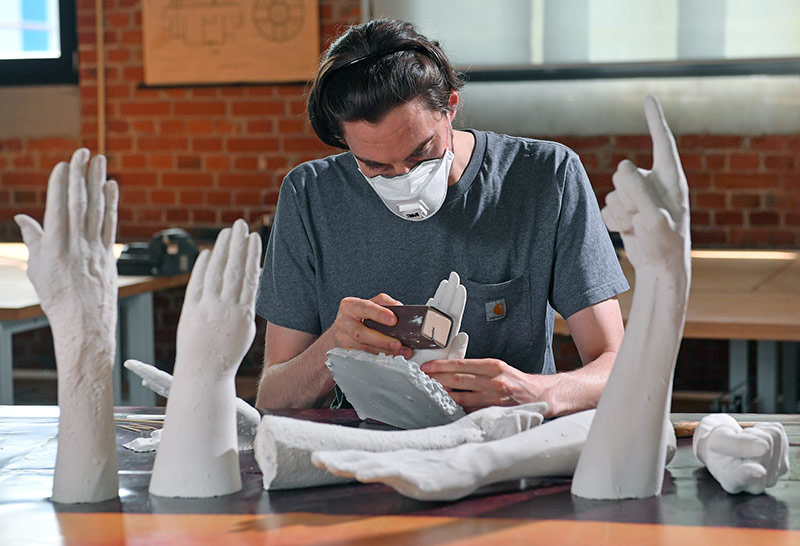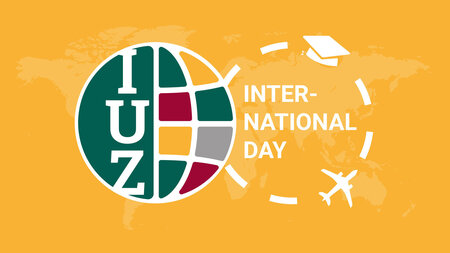Gestures: How hands talk, act, and work
The exhibition “Gestures – in past, present, and future” combines scientific, artistic, and technological perspectives on the human hand (Museum of Industry Chemnitz, 17 November 2017 – 4 March 2018)
-

Dirk Sorge is working on hand sculptures in the Museum of Industry Chemnitz, which will be shown during the exhibition “Gestures – in past, present, and future”. Photo: TU Chemnitz/Pressefoto Schmidt
“We are now at a point in history where the workplace, as we have traditionally known it, is rapidly transitioning. These technological and social developments have also fundamentally changed how we interact with objects”, says Ellen Fricke, professor of linguistics and semiotics at Chemnitz University of Technology. The role of the hand has always been essential for human cultures. Today, due to technological developments such as gesture control and automatization, new ways to manually interact with our surroundings are emerging. The exhibition focuses upon these developments at the intersection between gestures, technology, and the workplace.
Gestures store knowledge about the past
When we talk, we do not only use our mouths, but also our hands. Gestures are a part of everyday language. A thumbs up gesture, for example, signals consent. But we can also illustrate spatial conditions, visualize objects, or mimic actions. “Gestures store knowledge about the way we interact with objects, and therefore about present and past technology”, Fricke explains. She gives the phone gesture as an example, where the open hand with extended thumb and little finger is held next to the ear: the form of the hand still indicates the old telephone receiver, but can be used to refer to a modern smartphone.
Today, it is possible to control cars, robots, televisions, and smartphones with gestures. But how are these gestures established? What do gestures tell us about our language, culture, and technology? And how do they influence future developments? Gesture interfaces are a recent technology that is currently experiencing a breakthrough, with new applications emerging such as control of the “smart home” or communication with self-driving cars.
The “language of gestures” and the changing workplace
As outlined above, gestures can be understood as a focal point of current cultural and technological changes, both at the workplace and in daily communication. The exhibition ”Gestures – in past, present, and future” investigates these developments, offering fascinating interactive exhibits, art installations, and historical objects from the archives of the Museum of Industry Chemnitz.
How are gestures and language connected? What is the difference between a human and a robot hand? How can the same gesture be used to represent an airplane, and to control a virtual globe? What does an entry in a gesture lexicon look like? – The exhibitions answers these and other questions, offering a broad range of experiences for visitors of all ages.
Selected tools and machines from the museum’s archives will be on display. A “timeline of the telephone” will document how devices, as well as their handling and gestures referring to a telephone call, have changed during the 20th century. The visitors are invited to produce virtual pottery with a real pottery wheel – without touching it! Another project whose results can be experienced in the exhibition is a video documentary that documents the authentic use of traditional technologies, such as historic weaving looms. “The knowledge about the handling of these machines belongs to our cultural heritage, but could easily be lost due to the current technological changes”, opines Oliver Brehm, director of the Museum of Industry Chemnitz. „Our expertise is to combine our understanding of the functions of these historical machines, and the best methods for their preservation, with knowledge about how they were actually used at the workplace.”
“The whole project is characterized by experimental and artistic approaches that are integrated into a research perspective. This approach is visible throughout the exhibition, affording the visitors an unusual blend of analogue and digital. It throws new light on hands, gestures, and their relationship to objects”, explains Christopher Lindinger of the Ars Electronica Futurelab in Linz (Austria). As a research partner, the Futurelab has designed the exhibition in cooperation with the MANUACT project in Chemnitz. A number of impressive interactive exhibits were developed in this cooperation, which allow visitors to experience various aspects of gestures, gesture control, and workplace automatization.
The Ars Electronica Futurelab has also invited internationally renowned artists to contribute to the exhibition. Daniel Rozin (New York) created the interactive Wooden Mirror, which transforms a non-reflecting surface into a mirror. Hand and body movements of the spectator are captured by a camera, and 830 wooden plates produce an image of his body posture. Anette Rose’s (Berlin) video installation Captured Motion demonstrates the aesthetic potential of motion capture. In a walk-in cubic, visitors experience how words and gestures interact in the description of objects. Jennifer Crupi’s Gesture Jewelry solidifies certain hand and body movements into elegant steel contraptions. The wearer of this jewelry is forced to take on a certain body posture; the intricate hand-made pieces can be tried on by the visitors. In Golan Levin’s “Augmented Hand Series”, the visitor will have his hand transformed – be prepared to experience how it feels to have two left thumbs, or only four fingers! Further exhibits include 3D-printed sculptures of recorded gestures, and an interactive display demonstrating how “industry 4.0” works.
Special tours and workshops for schools are offered. In the workshops, students can learn how to manufacture hand dolls, how to construct a pneumatic grappler, or how to make a silent movie. Pupils from the 5th to the 10th grade are invited to participate in the photo competition “Talking Hands” with a photo of their favorite gesture (until 15 September 2017).
The exhibition is funded by the Federal Ministry of Education and Research (BMBF), the Ostdeutsche Sparkassenstiftung, the Sparkasse Chemnitz, the Kulturstiftung des Freistaates Sachsen, and the Freistaat Sachsen itself.
Homepage: www.gesten-im-museum.de
Opening hours of the Museum of Industry Chemnitz: Tuesday to Friday: 9 a.m. to 5 p.m./Saturday, Sunday, holiday: 10 a.m. to 5 p.m. /Special opening hours at New Years Eve.
For further information on the exhibition, please contact Dr. Oliver Brehm, email dr-brehm@saechsisches-industriemuseum.de phone +49 371 3676140/ Dr. Ellen Fricke, email secretariat.fricke@phil.tu-chemnitz.de phone +49 371 531 27220 (secretariat)/ Christopher Lindinger and Marianne Eisl, email Christopher.lindinger@aec.at, Marianne.eisl@aec.at, phone +43 732 727280
Background: Gestures and gesture research
Gestures have always been a part of human communication – some scientists believe them to be older than spoken language. Systematic scientific research on gestures, however, has only been conducted for a couple of decades. Ellen Fricke holds the chair for German Linguistics, Semiotics, and Multimodal Communication at the University of Technology Chemnitz. One of her research areas is the interaction between gestures and spoken language in face-to-face communication, aiming towards a description that integrates gesture and speech into a multimodal grammar.
The exhibition “Gestures – in past, present, and future” presents results of the research project MANUACT – Hands and Objects in Language, Culture, and Technology: Manual Actions at Workplaces, between Robotics, Gestures, and Product Design. The interdisciplinary project at the TU Chemnitz is funded by the Federal Ministry of Education and Research with 1.2 million Euros. The three-year project investigates the intersection between traditions of object use, their embodiment in gestures, and the design of manual interfaces.
Our natural gesture repertoire, comprising the gestures that we use in everyday communication, is relevant for the design of intuitive 3D interfaces with gesture control. Because certain gestures are already anchored in memory, they are easier to learn. The MANUACT project develops a prototype for a digital lexicon of object use gestures (gestures which refer to our usage of objects, i.e. a telephone). Such gestures also function as a cultural memory, because they store information about previous technologies and our handling of them. A further goal of the project is a manual of gesture ergonomics that evaluates gestures in regard to their suitability for human-machine interfaces.
MANUACT is a cooperation between the chair for German Linguistics, Semiotics, and Multimodal Communication (Prof. Ellen Fricke), TU Chemnitz, the chair for Ergonomics and Innovation Management (Prof. Angelika Bullinger-Hoffmann), TU Chemnitz, the Saxonian Museum of Industry Chemnitz, and the Ars Electronica Futurelab in Linz, Austria.
For further information, visit http://www.manuact.org
Mario Steinebach
04.09.2017




